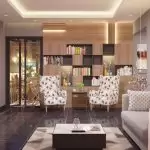Selecting the perfect paint color for your room can be an exciting yet overwhelming decision. With literally thousands of paint options to choose from, how do you even begin to narrow them down? Where you start comes down to determining the overall mood, functionality, and style you want to achieve tailored specifically to each space. Whether painting one accent wall or every room in your home, follow this structured approach for evaluating important factors from lighting to furnishings to successfully land on wall colors that meet your unique needs and sensibilities. Thinking through practical elements plus envisioning your aspirational color goals for each room sets you up for colors you’ll love for years to come.
Post your Requirement
|
Term |
Definition |
| Paint Color | Refers to the specific hue, shade, or combination of pigments used in paint to impart color to surfaces such as walls, ceilings, and other architectural elements. |
| Painters | Professionals skilled in the application of paint, are hired to paint surfaces to enhance aesthetics or provide protection, typically including walls, ceilings, and other structural elements. |
| Painters for Home | Painters specializing in residential painting projects, focusing on interior and exterior painting of houses, apartments, and other domestic properties. |
| Paint Color for Home | The selection and application of paint colors are specifically tailored for residential spaces, considering factors such as aesthetics, ambiance, and personal preferences. |
Here we have stated some of the tips to consider while choosing the right paint color for your space.
Determine Room Usage and Ambiance Goals
Start by outlining key details about the room:
- Functionality
- What activities happen in this space? Movie watching, cooking, entertaining guests, work productivity, etc.
- Need colors to complement primary usage.
- Natural vs. Artificial Lighting
- What direction do windows face? How much sunlight enters throughout the day? Need color enhancing not competing with natural light.
- Take stock of artificial lighting. More ornate fixtures may call for rich tones balancing intricacy.
- Bright overheads could wash out some hues.
- Desired Mood
- Use descriptive words envisioning the vibe you want to achieve – energetic, calm, cozy, cheerful, romantic, tranquil, inviting, etc.
- Consider when the room gets used – daytime refuge, evening entertaining, etc.
- Night colors feel more intense.
- Size/Proportions
- Small rooms feel expansive with soft light colors.
- Bold tones in big rooms add visual interest.
- Tall ceilings handle deeper shades, not overwhelming space.
- Soft hues keep low ceilings feeling airy.
Thinking through these elements for each specific room provides the framing to start matching potential colors to the aesthetics and functionality you aim to create in the space.
Assess Architectural Features and Furnishings
Interior architectural elements and décor also impact paint decisions:
- Architectural Moldings
- Ornate crown molding and chair rails suit elegant paint tones complementing their detail.
- Simple trim blends well with trendy color choices.
- Flooring
- Lighter wall colors connect airy visual space with light hardwoods.
- Darker floors ground bold wall colors through continuity of tone.
- Furniture Pieces
- Match bolder furniture with coordinating saturated wall colors.
- Neutral furniture has flexibility across paint choices.
- Future furniture purchases may guide color selection for long-term cohesion.
- Permanent Features
- Fireplace bricks or stone, built-in shelving, etc. factor into color compatibility.
- Neutral backdrops add versatility.
Whatever permanent elements exist in the room, choose wall paint assimilating or enhancing their fixed styles and finishes. This ensures your color selection remains evergreen should you update other furnishings down the road.
Identify Your Color Palette Preferences
Advance your decision process by identifying color styles you gravitate towards:
- Warm vs. Cool Tones
- Warm Tones (reds, yellows) energize spaces eliciting cheeriness and coziness more so than cool tones (blues, greens).
- Bright vs. Muted Tones
- Soft muted tones add relaxed elegance.
- Bright bold colors amp up visual dynamism.
- Monochromatic vs. Contrasting Colors
- Monochromatic sticking to shades of similar tones, adds calming flow.
- Contrasting colors create a definite separation between elements.
- Neutral Backgrounds vs. Saturated Accents
- Neutral backdrops (beige, gray) offer flexibility.
- Saturated accent walls make bold color statements.
Further articulate the aesthetics you want the color to achieve – traditional, contemporary, rustic, industrial, or minimalistic. This narrows options aligned to the style you envision. Whether aiming for subtle and airy or dramatic and lively, outlining these preferences focuses your search on suitable colors meeting room goals.
Narrow Down Specific Color Families
Now begin browsing paint colors and swatches that align with the aesthetics, ambiance, and styles you outlined. Target colors within the following groups matching your top criteria:
- Reds
- Range from vibrant crimsons to muted clay reds.
- Energize spaces eliciting passion and excitement.
- Reds complement dark wood tones.
- Oranges
- Uplifting and playful. Soft peaches to deep burnt oranges.
- Coordinate with yellow and brown.
- Yellows
- Cheerful sunshine tones.
- Airy pastels for small spaces to bold gingers and mustards in expansive rooms.
- Challenging pairing with some wood tones.
- Greens
- Calming nature-inspired greenish blues to revitalize lime greens.
- Ideal for dining room spaces.
- Also popular for bathrooms and bedrooms.
- Blues
- Versatile suiting traditional to modern spaces.
- Navy and denim blues add cozy, enveloping depth.
- Robin’s egg blue for uplifting pastel vibe.
- Purples
- Regal and feminine.
- Soft lavenders and lilacs for a calm effect.
- Bold jewel tones like royal purples make distinctive accents.
- Browns
- Warming earth tones.
- Light beiges/browns keep rooms feeling spacious, and airy.
- Dark chocolate browns cocoon intimacy.
- Grays:
- Sophisticated neutral adaptable across rooms.
- Warm grays cozy up spaces.
- Cool grays recede adding lightness.
- Dig into categories resonating based on your goals, architectural elements, and color preferences for rooms.
Order Paint Swatches Aligning to Style
After identifying potential color families for rooms, order an array of corresponding paint color swatches. Sherwin Williams, Behr, and Benjamin Moore are popular brands offering many on-trend options.
Gather a spread sticking to your shortlist parameters
- Various shades of your top-color families.
- The mix of muted and bright tones.
- Some neutral whites/grays if desired as backgrounds.
- One swatch slightly outside your envisioned palette just in case.
With swatches in hand, evaluate them in your space at different times of day. Note how lighting interacts across the hours – some may appear soft morning light but too intense at noon. Add finalist swatches to the wall and live with them for a few days noticing how you feel. Thorough swatch testing prevents color commitment regrets down the road.
Pull It All Together with Whole Home Cohesion
As you finalize paint decisions per room, take a step back and evaluate colors holistically across your home. Aim for an intentional flow from space to space.
Consider:
Focal Points
- Your front door color makes a first impression. Use brighter, welcoming tones guests see immediately.
- Public living spaces suit flexible styles blending cohesively across open floorplans.
- Personal spaces can showcase bold distinct colors and palettes.
Color Transitions
- Vary intensities across rooms moving lighter/brighter public spaces to darker/muted private rooms.
- Repeat a color in a new room through artwork, textiles, or accessories for visual connectivity.
- Use adjacent walls or hallways to gracefully transition colors from one space to the next.
Whole Home Harmony
- Determine one or two colors making repeat appearances across rooms through artwork, pillows, furniture, etc. Consistency promotes visual flow.
- Coordinate, not match – colors working together through complementary tones prevent dominance by one.
- Neutral bridges (whites/grays) between vivid rooms keep spaces feeling unified, not disjointed.
Stepping back and curating colors holistically room-to-room ensures a harmonious flow punctuated by unique personality and style in each living space.
Conclusion
Selecting paint colors for your home requires thoughtfulness in assessing practical lighting elements along with the aspirational mood and style envisioned for each space. Moving methodically from broadly outlining your aesthetic goals per room to zeroing in on the specific color families meeting those needs helps narrow down the perfect on-trend paint color specifically tailored to your unique home and sensibilities. Properly sampling swatches following your established criteria streamlines decision-making and finally ensures some consistency yet still allows bold colors and diverse palettes between adjoining spaces pulling the whole home together compositionally. Following this structured playbook for determining paint colors, room-by-room allows you to achieve a cohesive, harmonious home reflecting your personal color preferences and style. Just remember, there are no absolute rights and wrongs with paint colors if you follow the process of aligning selections clearly to your functional needs and intended ambiance per space while balancing out bolder colors and style divergences holistically home-to-home.























Post A Comment